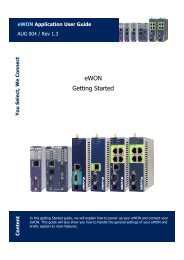Click to download Ethernet Basics manual - Grant Industrial Controls
Click to download Ethernet Basics manual - Grant Industrial Controls
Click to download Ethernet Basics manual - Grant Industrial Controls
You also want an ePaper? Increase the reach of your titles
YUMPU automatically turns print PDFs into web optimized ePapers that Google loves.
<strong>Ethernet</strong> 21<br />
If a host wishes <strong>to</strong> send a message, then first the medium has <strong>to</strong> be listened <strong>to</strong>. If the<br />
medium is longer than the time DIFS is free, then this participant can take the initiative <strong>to</strong><br />
send a message.<br />
If it appears that the medium is occupied, then one has <strong>to</strong> wait until the sending participant<br />
has completed the sending. Then a DIFS time has <strong>to</strong> be waited. The access point has a higher<br />
priority and only has <strong>to</strong> wait for a SIFS time. If the medium is still free after the DIFS time,<br />
then the recovery phase starts whereby every host, that wants <strong>to</strong> send data, starts a random<br />
backoff timer. The participant that has completed the counting first, can take the initiative <strong>to</strong><br />
use the medium and send the data.<br />
2.4 Structure elements for <strong>Ethernet</strong><br />
2.4.1 The hub<br />
The maximum segment length of a LAN is determined by the used medium and the applied<br />
access mechanism. In order <strong>to</strong> cancel the length restriction, methods are rapidly searched<br />
<strong>to</strong> link several segments one after another. The first and most simple method is <strong>to</strong> use a<br />
repeater. A repeater is a signal amplifier that transmits packets transparently, independent of<br />
the package content. A repeater is used <strong>to</strong> connect two or more <strong>Ethernet</strong> segments <strong>to</strong>gether.<br />
As can be seen on the slight , a repeater link takes place on the physical layer, in accordance<br />
with the ISO-OSI definitions.<br />
Figure 2.15: The repeater in accordance with the OSI model<br />
Both segments can have a different medium. A 10Base-T based segment, for example, can<br />
be connected <strong>to</strong> a fibre glass segment by means of a repeater. Another important feature<br />
of a link on the basis of a repeater is that not only the data bits are transmitted but also<br />
any collisions and signal errors. Network segments that are connected mutually via a repeater<br />
are therefore prone <strong>to</strong> fault situations; a problem on one segment multiplies over all<br />
other segments. In modern local networks, based on <strong>Ethernet</strong>, repeaters are mainly used<br />
<strong>to</strong> connect segments of different media with each other. The backbone segments from fibre




